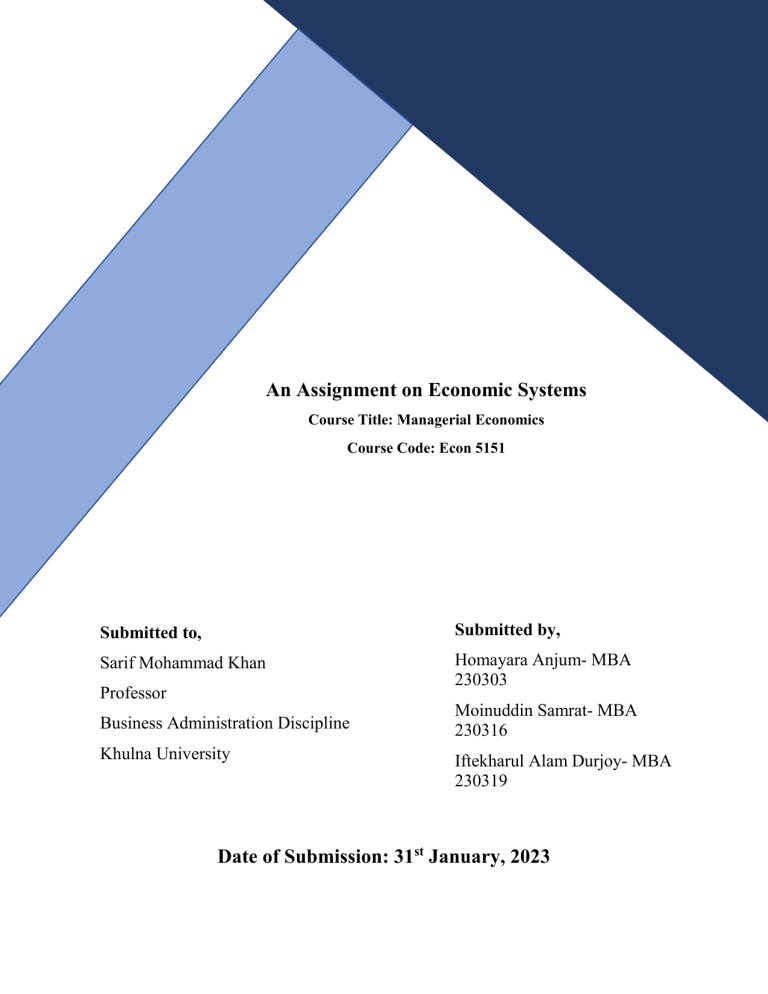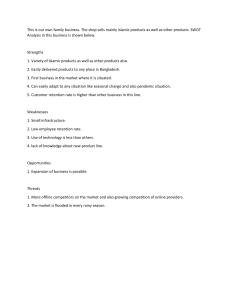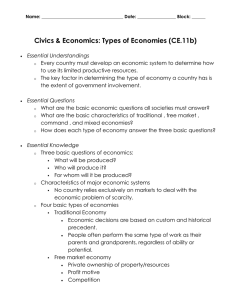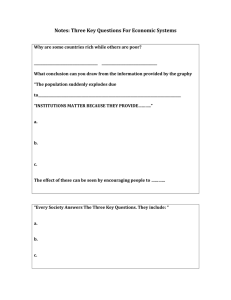Economic Systems Assignment: Market, Command, Mixed, Islamic
advertisement

An Assignment on Economic Systems Course Title: Managerial Economics Course Code: Econ 5151 Submitted to, Submitted by, Sarif Mohammad Khan Homayara Anjum- MBA 230303 Professor Business Administration Discipline Khulna University Moinuddin Samrat- MBA 230316 Iftekharul Alam Durjoy- MBA 230319 Date of Submission: 31st January, 2023 Introduction Economics is the social science that studies the production, distribution, and consumption of goods and services. It is concerned with how societies allocate scarce resources among competing needs and wants. Economic systems, on the other hand, refer to the institutions and mechanisms that a society uses to allocate resources, distribute goods and services, and determine prices. Economic systems are not fixed and unchanging. They evolve over time in response to changing economic and political conditions. It is important to note that no economic system is perfect and each has its own set of pros and cons, it's up to the society to select which one will work best for them. Market Economy A market economy is an economic system in which economic decisions and the pricing of goods and services are guided by the interactions of a country's individual citizens and businesses, rather than by government intervention. In a market economy, the laws of supply and demand determine the prices of goods and services, and production and consumption are guided by the profit motive. In a market economy, individuals and businesses are free to make their own economic decisions. Consumers decide what to buy, and businesses decide what to produce, how much to produce, and at what price to sell their products. Prices are determined by the interaction of supply and demand in a competitive marketplace. When demand for a product is high and supply is low, the price will increase. When demand is low and supply is high, the price will decrease. Features of Market Economy Private property rights: Market economies rely on the ability of individuals and businesses to own and control the resources they use to produce goods and services. Profit motive: Businesses in a market economy strive to make a profit by producing goods and services that consumers are willing to buy at a higher price than the cost of producing them. Competition: Market economies promote competition among businesses, which helps to keep prices low and quality high. Supply and demand: Prices are determined by the interaction of supply and demand in a competitive marketplace. 1 Consumer sovereignty: Consumers have the power to influence the economy by deciding what to buy, and businesses must respond to consumers’ preferences. Decentralized decision-making: Economic decisions are made by a large number of individuals and businesses rather than by a central authority. Flexibility: Market economies are able to adjust to changes in supply and demand quickly and efficiently. Free flow of information: A market economy relies on the free flow of information, which allows consumers and businesses to make informed decisions. Market-based allocation of resources: Market economies allocate resources to their most highly valued uses. Limited government intervention: Market economies are characterized by limited government intervention in the economy, allowing for more freedom for individuals and businesses to make their own economic decisions. Command Economy Command economy is an economic system where the central government or a single person controls the production and distribution of goods and services. The government decides what goods will be produced, how they will be produced, and for whom they will be produced. The government also sets prices and allocates resources. There is little or no role for market forces in a command economy, and individual choices and freedoms are often limited. Features of Command Economy Centralized control: The government makes all economic decisions. Government ownership of means of production: The government owns and controls the major industries and businesses. Lack of market forces: Prices, production and distribution are determined by the government, not by supply and demand. Limited consumer choice: The government decides what goods and services are available and at what prices. No competition: There is no competition between businesses, as the government controls them all. 2 No profit motive: Businesses do not operate for profit, but to fulfill governmentdetermined goals. Equitable distribution: The government aims to distribute goods and services equally among citizens. Low efficiency: Due to the lack of market incentives, inefficiencies and waste can occur in a command economy. Lack of consumer sovereignty: Consumers do not have the power to influence what is produced and how it is produced. Reduced innovation: The lack of competition and profit motive can lead to reduced investment in research and development. Mix Economy Mixed economy is an economic system that combines elements of a market economy and a command economy. It is characterized by a combination of private enterprise and government intervention. In a mixed economy, some industries are owned and operated by the private sector, while others are owned and controlled by the government. The government also regulates certain aspects of the economy, such as setting prices, controlling inflation, and protecting the rights of consumers. This type of economy is often seen as a balance between the efficiency and flexibility of a market economy and the stability and fairness of a command economy. Features of Mix Economy Private and public ownership of the means of production Market-determined prices, with some government intervention Competition and freedom of choice in economic activities Regulation of certain industries for the public good Provision of public goods and services by the government. 3 Islamic Economy Islamic economy is an economic system based on the principles of Islamic law (Sharia). It seeks to promote ethics and morality in economic transactions, and to ensure social justice and fairness. One of the fundamental principles of Islamic economics is the prohibition of interest-based transactions (riba), which is seen as exploitative. Instead, Islamic finance offers alternatives such as profit-and-loss sharing (Mudharabah) and joint venture financing (Musharakah). In Islamic economics, wealth creation is not an end in itself, but a means to achieve social justice and the betterment of society. The focus is on fair distribution of wealth and resources, and the promotion of equity in economic transactions. The Qur'an encourages Muslims to engage in trade and commerce, but also to avoid greed and to conduct business ethically. Features of Islamic Economy Prohibition of interest-based transactions (riba). Promotion of equity and fairness in economic transactions. Encouragement of social justice and distribution of wealth. Promotion of ethics and moral values in business dealings. Prohibition of speculative and unethical practices. Emphasis on corporate social responsibility. Recognition of the interdependence of economic, social, and environmental factors. Comparison and Compatibility of Different Economic System A money market economy relies on market forces to allocate goods and services, with a strong emphasis on private enterprise. In contrast, a command economy is centrally controlled by the government, with little role for market forces. A mixed economy combines elements of both market and command economies, balancing government regulation and private sector entrepreneurship. Islamic economy, on the other hand, is based on Islamic principles and values, such as fair trade and profit and loss sharing, and prohibits interest-based transactions. In terms of efficiency, a money market economy is generally seen as providing greater economic freedom and promoting innovation and growth, while command economies can lead to inefficiency and a lack of consumer choice. Mixed economies aim to strike a balance between 4 government intervention and market freedom, while Islamic economies prioritize ethical and moral considerations in economic decision-making. Each system has its strengths and weaknesses and the choice of which to implement is often dependent on a country's cultural, political, and historical context. Compatibility between economic systems depends on various factors such as cultural values, political stability, and historical context. In general, a mix of money market and command market is considered to be the most compatible as it balances individual freedom and equality. Ultimately, the most compatible economic system for a country will depend on its specific needs, resources, and political and cultural context. Each system has its strengths and weaknesses, and a successful economy will often combine elements of different systems in a way that works best for that particular country. Conclusion In conclusion, different economic systems offer various approaches to organizing and managing economic activity, and each system has its strengths and weaknesses. The choice of an economic system will depend on the goals and values of the society, as well as the cultural, political, and historical context. The effectiveness of an economic system will depend on its implementation and the ability of the government to effectively regulate and manage the economy. The ongoing process of economic development and global interconnectedness will continue to shape the evolution of economic systems and the pursuit of economic prosperity and well-being for all. 5



